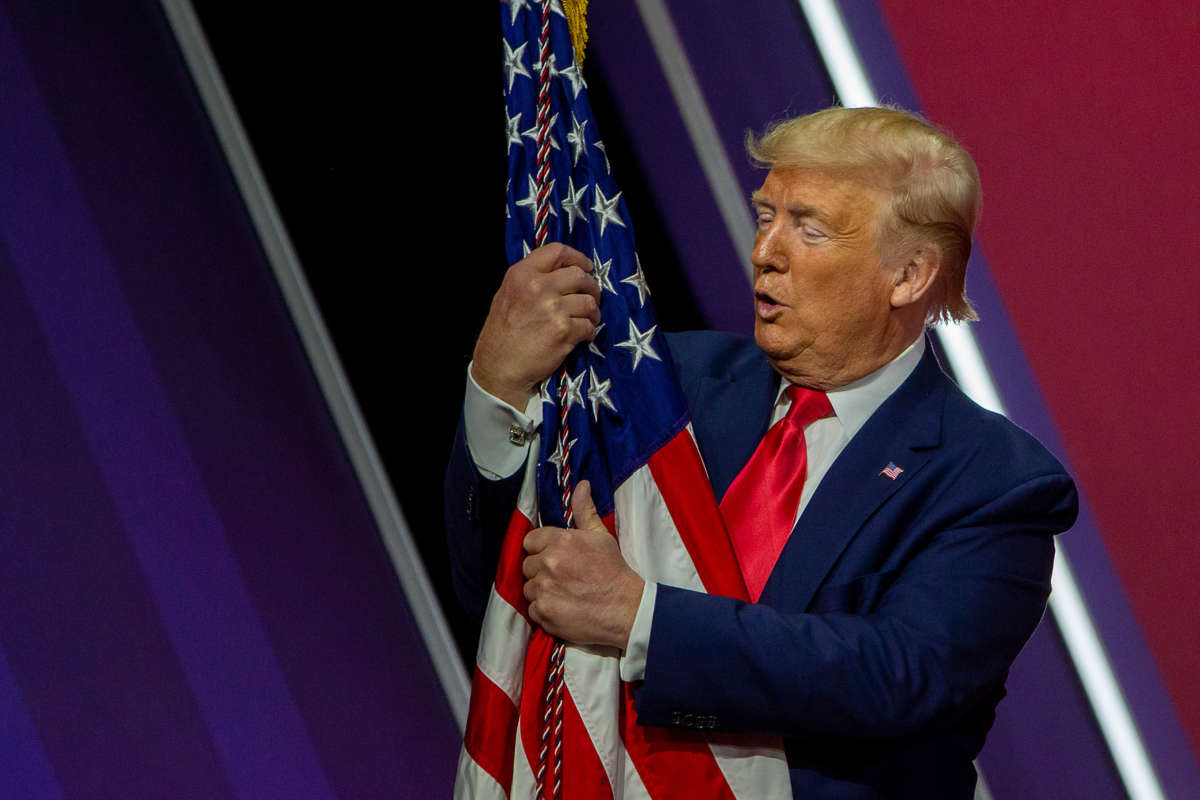Former President Donald Trump described the mob of his loyalists who attacked the Capitol building in January as a “loving crowd” during an interview with authors of a book examining his final year in office.
The Washington Post released audio on Wednesday night of an interview between Trump and journalists Carol Leonnig and Philip Rucker, authors of the recently released book I Alone Can Fix It: Donald J. Trump’s Catastrophic Final Year. While speaking to them in March at his Mar-a-Lago club in Palm Beach, Florida, Trump described a vastly different story about what happened on January 6 than what the record shows.
After giving a speech in Washington, D.C., where he told his supporters that they needed to “show strength” and that they should “walk down to the Capitol” to express their grievances about the election, thousands of Trump loyalists broke through barricades, windows and doors, disrupting the certification of the 2020 presidential race. In total, five individuals lost their lives in the ensuing chaos.
“Personally what I wanted is what they wanted,” Trump said of his loyalists who came to D.C. that day. “They showed up just to show support because I happen to believe the election was rigged at a level like nothing has ever been rigged before.”
There is no evidence to back Trump’s claims that widespread election fraud affected the outcome of the presidential race.
AUDIO: Trump told @PhilipRucker and @CarolLeonnig that there was "a lot of love" and "hugging & kissing" on January 6 during the Capitol insurrection.
Learn more: https://t.co/IQFul2rTiE#11thHour pic.twitter.com/wXbvo1jaRH
— 11th Hour (@11thHour) July 22, 2021
“It was a loving crowd too, by the way, there was a lot of love,” Trump said of the day’s events, adding that he’s heard from “many, many people” that it “was a loving crowd.”
Possibly recognizing that his words didn’t match with the events of that day, Trump added it was “too bad” about what had happened.
Trump also avoided answering a question about what he had intended for his followers to do when he had told them to convene at the Capitol. Instead, Trump errantly suggested that police had “ushered in” his mob inside the building.
“The Capitol Police were very friendly. You know, they were hugging and kissing. You don’t see that,” Trump added.
Trump’s claims about the Capitol police have also not been substantiated, and appear to rely on social media videos shared without context. According to the journalist who recorded them, officers were actually just backing off of the barricades because they were “completely outnumbered.”
Nearly seven months after the breach of the Capitol, more than 535 individuals have been charged for their actions that day, and the identities of more than 300 suspects remain unknown, according to the Department of Justice.
Attempts to create a congressional commission to investigate the attack on the Capitol have stalled this week, after House Minority Leader Kevin McCarthy (R-California) selected five individuals to take part in a select committee established late last month. Two of the individuals McCarthy had selected to serve on that committee, Rep. Jim Jordan (R-Ohio) and Rep. Jim Banks (R-Indiana), had voted against certifying the results of the Electoral College.
Speaker of the House Nancy Pelosi (D-California), who has the ability to reject McCarthy’s picks, removed Jordan and Banks, accepting the other three individuals McCarthy had picked. Following Pelosi’s move, McCarthy withdrew all five of his picks for the select committee in protest.
Our most important fundraising appeal of the year
December is the most critical time of year for Truthout, because our nonprofit news is funded almost entirely by individual donations from readers like you. So before you navigate away, we ask that you take just a second to support Truthout with a tax-deductible donation.
This year is a little different. We are up against a far-reaching, wide-scale attack on press freedom coming from the Trump administration. 2025 was a year of frightening censorship, news industry corporate consolidation, and worsening financial conditions for progressive nonprofits across the board.
We can only resist Trump’s agenda by cultivating a strong base of support. The right-wing mediasphere is funded comfortably by billionaire owners and venture capitalist philanthropists. At Truthout, we have you.
We’ve set an ambitious target for our year-end campaign — a goal of $211,000 to keep up our fight against authoritarianism in 2026. Please take a meaningful action in this fight: make a one-time or monthly donation to Truthout before December 31. If you have the means, please dig deep.
